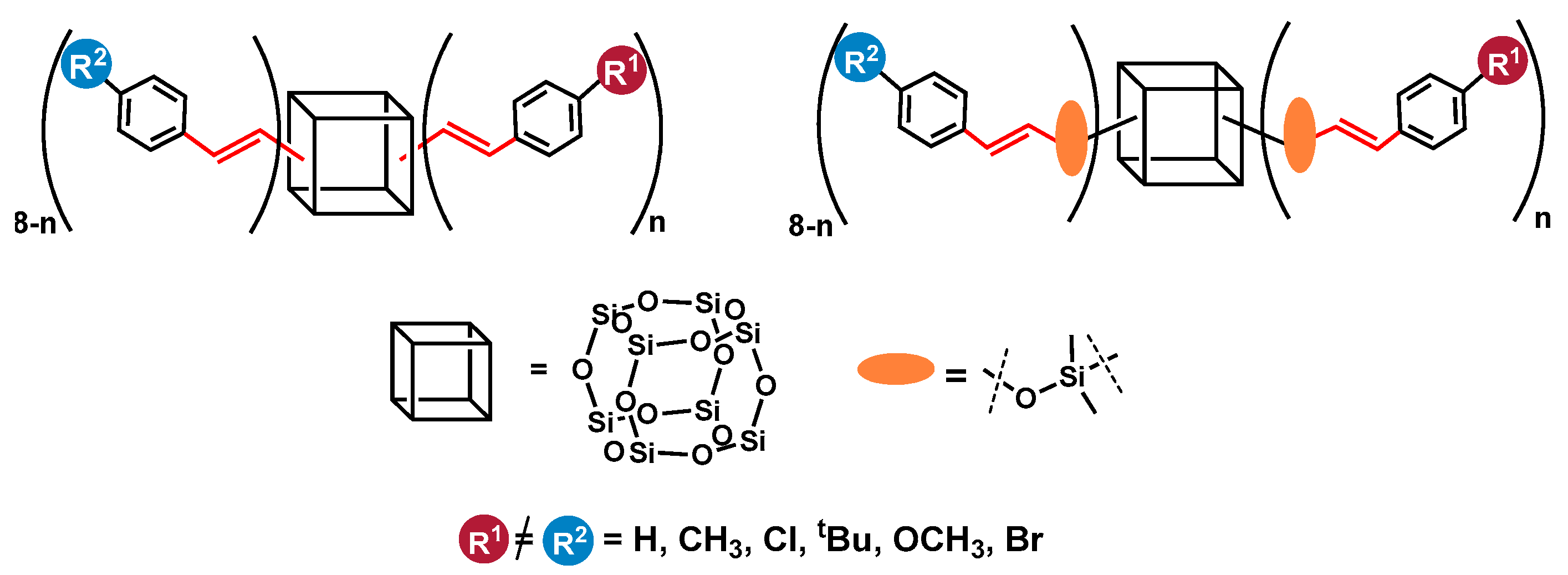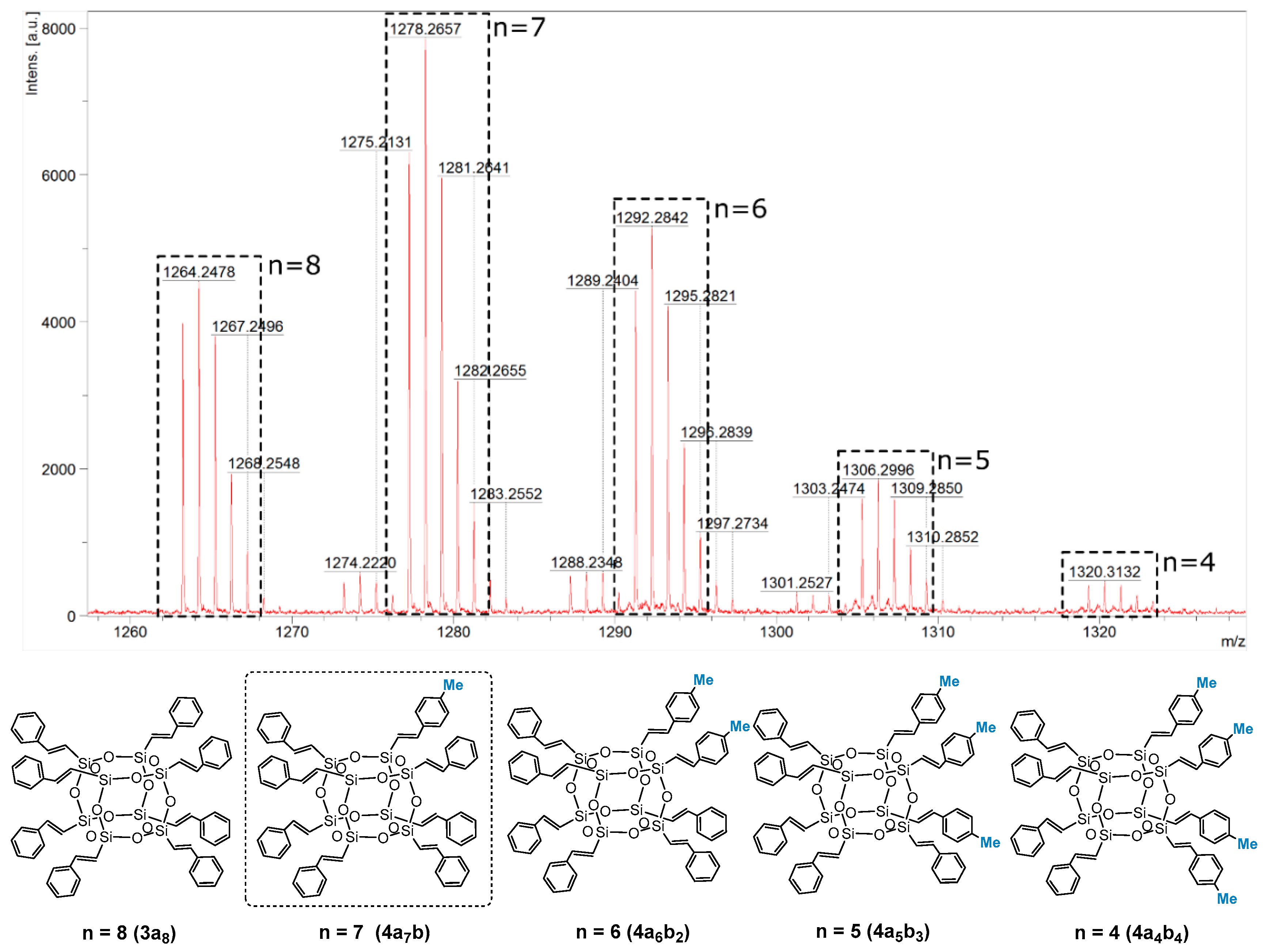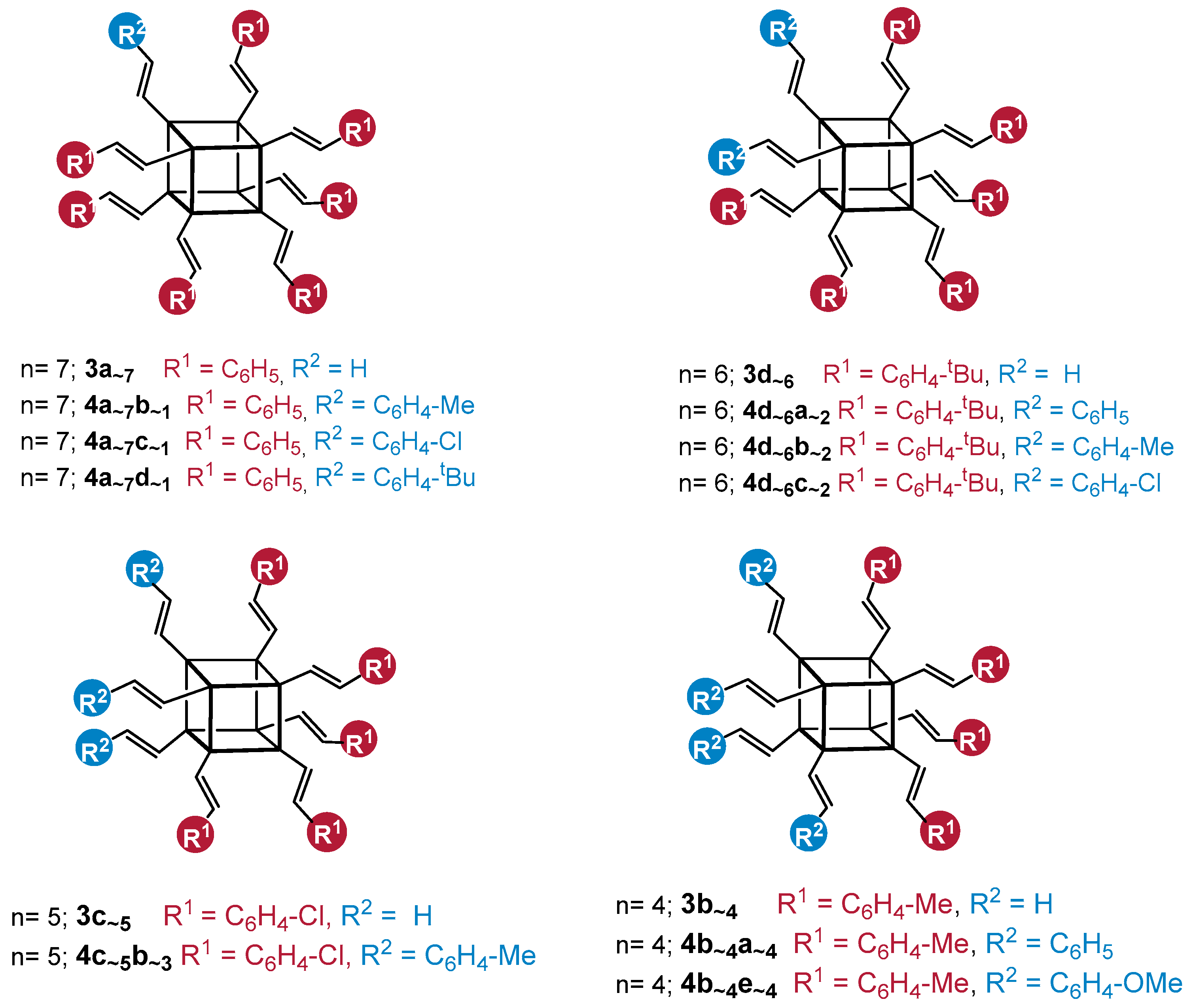Formation of Bifunctional Octasilsesquioxanes via Silylative Coupling and Cross-Metathesis Reaction †
Abstract
1. Introduction
2. Materials and Methods
2.1. Materials
2.2. Nuclear Magnetic Resonance Spectroscopy (NMR)
2.3. Matrix-Assisted Ultraviolet Laser Desorption/Ionization Time-of-Flight Mass Spectroscopy (MALDI-TOF-MS)
2.4. FT-IR Spectroscopy
2.5. Synthesis of Bifunctional Silsesquioxanes via Cross-Metathesis
2.6. Synthesis of Bifunctional Silsesquioxanes via Cross-Metathesis in a One-Pot Manner
2.7. Synthesis of Bifunctional Silsesquioxanes via Silylative Coupling
2.8. Synthesis of Bifunctional Silsesquioxanes via Silylative Coupling in a One-Pot Manner
3. Results and Discussion
3.1. Functionalization of Octa(vinyl)silsesquioxanes (OVS) via Cross-Metathesis Reaction
3.2. Functionalization of Octakis(dimethylvinylsilyloxy)silsesquioxane (Q8M8)-Silylative Coupling
4. Conclusions
Supplementary Materials
Author Contributions
Funding
Conflicts of Interest
References
- Cordes, D.B.; Lickiss, P.D.; Rataboul, F. Recent developments in the chemistry of cubic polyhedral oligosilsesquioxanes. Chem. Rev. 2010, 110, 2081–2173. [Google Scholar] [CrossRef] [PubMed]
- Chen, F.; Lin, F.; Zhang, Q.; Cai, R.; Wu, Y.; Ma, X. Polyhedral Oligomeric Silsesquioxane Hybrid Polymers: Well-Defined Architectural Design and Potential Functional Applications. Macromol. Rapid Commun. 2019, 40, 1900101. [Google Scholar] [CrossRef] [PubMed]
- Wang, D.; Sun, R.; Feng, S.; Li, W.; Liu, H. Retrieving the original appearance of polyhedral oligomeric silsesquioxane-based porous polymers. Polymer 2017, 130, 218–229. [Google Scholar] [CrossRef]
- Ge, M.; Liu, H. Fluorine-Containing Silsesquioxane-Based Hybrid Porous Polymers Mediated by Bases and Their Use in Water Remediation. Chem. A Eur. J. 2018, 24, 2224–2231. [Google Scholar] [CrossRef] [PubMed]
- Sun, R.; Feng, S.; Wang, D.; Liu, H. Fluorescence-Tuned Silicone Elastomers for Multicolored Ultraviolet Light-Emitting Diodes: Realizing the Processability of Polyhedral Oligomeric Silsesquioxane-Based Hybrid Porous Polymers. Chem. Mater. 2018, 30, 6370–6376. [Google Scholar] [CrossRef]
- Asuncion, M.Z.; Roll, M.F.; Laine, R.M. Octaalkynylsilsesquioxanes, Nano Sea Urchin Molecular Building Blocks for 3-D-Nanostructures. Macromolecules 2008, 41, 8047–8052. [Google Scholar] [CrossRef]
- Walczak, M.; Januszewski, R.; Dutkiewicz, M.; Franczyk, A.; Marciniec, B. A facile approach for the synthesis of novel silsesquioxanes with mixed functional groups. New J. Chem. 2019, 43, 18141–18145. [Google Scholar] [CrossRef]
- Walczak, M.; Franczyk, A.; Dutkiewicz, M.; Marciniec, B. Synthesis of Bifunctional Silsesquioxanes (RSiMe2O)∼4(R′SiMe2O)∼4Si8O12 via Hydrosilylation of Alkenes. Organometallics 2019, 38, 3018–3024. [Google Scholar] [CrossRef]
- Franczyk, A.; Stefanowska, K.; Dutkiewicz, M.; Frąckowiak, D.; Marciniec, B. A highly selective synthesis of new alkenylsilsesquioxanes by hydrosilylation of alkynes. Dalton Trans. 2017, 46, 158–164. [Google Scholar] [CrossRef]
- Dutkiewicz, M.; MacIejewski, H.; Marciniec, B.; Karasiewicz, J. New fluorocarbofunctional spherosilicates: Synthesis and characterization. Organometallics 2011, 30, 2149–2153. [Google Scholar] [CrossRef]
- Grzelak, M.; Januszewski, R.; Marciniec, B. Synthesis and Hydrosilylation of Vinyl-Substituted Open-Cage Silsesquioxanes with Phenylsilanes: Regioselective Synthesis of Trifunctional Silsesquioxanes. Inorg. Chem. 2020, 59, 7830–7840. [Google Scholar] [CrossRef] [PubMed]
- Grzelak, M.M.; Marciniec, B. Synthesis of bifunctional silsesquioxanes and spherosilicates with organogermyl functionalities. Chem. Asian J. 2020, 15, 2437–2441. [Google Scholar] [CrossRef] [PubMed]
- Stefanowska, K.; Franczyk, A.; Szyling, J.; Walkowiak, J. Synthesis of Functional 3-Buten-1-ynes and 1,3-Butadienes with Silsesquioxane Moiety via Hydrosilylation of 1,3-Diynes. ChemCatChem 2019, 11, 4848–4853. [Google Scholar] [CrossRef]
- Walczak, M.; Januszewski, R.; Franczyk, A.; Marciniec, B. Synthesis of monofunctionalized POSS through hydrosilylation. J. Organomet. Chem. 2018, 872, 73–78. [Google Scholar] [CrossRef]
- Walczak, M.; Stefanowska, K.; Franczyk, A.; Walkowiak, J.; Wawrzyńczak, A.; Marciniec, B. Hydrosilylation of alkenes and alkynes with silsesquioxane (HSiMe2O)(i-Bu)7Si8O12 catalyzed by Pt supported on a styrene-divinylbenzene copolymer. J. Catal. 2018, 367, 1–6. [Google Scholar] [CrossRef]
- Żak, P.; Pietraszuk, C. Application of olefin metathesis in the synthesis of functionalized polyhedral oligomeric silsesquioxanes (POSS) and POSS-containing polymeric materials. Beilstein J. Org. Chem. 2019, 15, 310–332. [Google Scholar] [CrossRef]
- Zak, P.; Marciniec, B.; Majchrzak, M.; Pietraszuk, C. Highly effective synthesis of vinylfunctionalised cubic silsesquioxanes. J. Organomet. Chem. 2011, 696, 887–891. [Google Scholar] [CrossRef]
- Sulaiman, S.; Bhaskar, A.; Zhang, J.; Guda, R.; Goodson, T.; Laine, R.M. Molecules with perfect cubic symmetry as nanobuilding blocks for 3-D assemblies. Elaboration of octavinylsilsesquioxane. Unusual luminescence shifts may indicate extended conjugation involving the silsesquioxane core. Chem. Mater. 2008, 20, 5563–5573. [Google Scholar] [CrossRef]
- Cheng, G.; Vautravers, N.R.; Morris, R.E.; Cole-Hamilton, D.J. Synthesis of functional cubes from octavinylsilsesquioxane (OVS). Org. Biomol. Chem. 2008, 6, 4662–4667. [Google Scholar] [CrossRef]
- Zak, P.; Pietraszuk, C.; Marciniec, B.; Spólnik, B.; Danikiewicz, W. Efficient functionalisation of cubic monovinylsilsesquioxanes via cross-metathesis and silylative coupling with olefins in the presence of ruthenium complexes. Adv. Synth. Catal. 2009, 351, 2675–2682. [Google Scholar] [CrossRef]
- Kaźmierczak, J.; Kuciński, K.; Hreczycho, G. Highly Efficient Catalytic Route for the Synthesis of Functionalized Silsesquioxanes. Inorg. Chem. 2017, 56, 9337–9342. [Google Scholar] [CrossRef] [PubMed]
- Kaźmierczak, J.; Hreczycho, G. Nafion as effective and selective heterogeneous catalytic system in O-metalation of silanols and POSS silanols. J. Catal. 2018, 367, 95–103. [Google Scholar] [CrossRef]
- Du, Y.; Liu, H. Cage-like silsesquioxanes-based hybrid materials. Dalton Trans. 2020, 49, 5396–5405. [Google Scholar] [CrossRef] [PubMed]
- Dudziec, B.; Zak, P.; Marciniec, B. Synthetic routes to silsesquioxane-based systems as photoactive materials and their precursors. Polymers 2019, 11, 504. [Google Scholar] [CrossRef] [PubMed]
- Hartmann-Thompson, C. Applications of Polyhedral Oligomeric Silsesquioxanes; Springer: Berlin/Heidelberg, Germany, 2011; ISBN 9789048137862. [Google Scholar]
- Kalia, S.; Pielichowski, K. Polymer/POSS Nanocomposites and Hybrid Materials; Springer: Berlin/Heidelberg, Germany, 2018; ISBN 978-3-030-02326-3. [Google Scholar]
- Sellinger, A.; Laine, R.M. Silsesquioxanes as synthetic platforms. Thermally curable and photocurable inorganic/organic hybrids. Macromolecules 1996, 29, 2327–2330. [Google Scholar] [CrossRef]
- Sellinger, A.; Tamaki, R.; Laine, R.M.; Ueno, K.; Tanabe, H.; Williams, E.; Jabbour, G.E. Heck coupling of haloaromatics with octavinylsilsesquioxane: Solution processable nanocomposites for application in electroluminescent devices. Chem. Commun. 2005, 29, 3700–3702. [Google Scholar] [CrossRef]
- Wang, S.; Guang, S.; Xu, H.; Ke, F. Controllable preparation and properties of active functional hybrid materials with different chromophores. RSC Adv. 2015, 5, 1070–1078. [Google Scholar] [CrossRef]
- Zhao, G.; Gong, X.; Wei, G.; Liu, Q.; Guang, S.; Zhang, F.; Ke, F.; Xu, H. Facile preparation and properties of polyhedral oligomeric silsesquioxane (POSS) nano-hybrid materials with disaggregation effect. Mater. Sci. Eng. B 2019, 246, 136–142. [Google Scholar] [CrossRef]
- Chanmungkalakul, S.; Ervithayasuporn, V.; Boonkitti, P.; Phuekphong, A.; Prigyai, N.; Kladsomboon, S.; Kiatkamjornwong, S. Anion identification using silsesquioxane cages. Chem. Sci. 2018, 9, 7753–7765. [Google Scholar] [CrossRef]
- Oguri, N.; Egawa, Y.; Takeda, N.; Unno, M. Janus-Cube Octasilsesquioxane: Facile Synthesis and Structure Elucidation. Angew. Chem. Int. Ed. 2016, 55, 1–5. [Google Scholar]
- Takeuchi, H.; Konno, T.; Mori, H. Synthesis of multifunctional silsesquioxane nanoparticles with hydroxyl and polymerizable groups for UV-curable hybrid coating. React. Funct. Polym. 2017, 115, 43–52. [Google Scholar] [CrossRef]
- Sasaki, Y.; Shibasaki, S.; Lo, C.T.; Nakabayashi, K.; Mori, H. Design and synthesis of multi-functional silsesquioxane nanoparticles having two distinct optoelectronic functionalities. Colloid Polym. Sci. 2018, 296, 1017–1028. [Google Scholar] [CrossRef]
- Shibasaki, S.; Sasaki, Y.; Nakabayashi, K.; Mori, H. Synthesis and metal complexation of dual-functionalized silsesquioxane nanoparticles by sequential thiol–epoxy click and esterification reactions. React. Funct. Polym. 2016, 107, 11–19. [Google Scholar] [CrossRef]
- Uchida, T.; Egawa, Y.; Adachi, T.; Oguri, N.; Kobayashi, M.; Kudo, T.; Takeda, N.; Unno, M.; Tanaka, R. Synthesis, Structures, and Thermal Properties of Symmetric and Janus “Lantern Cage” Siloxanes. Chem. A Eur. J. 2019, 25, 1683–1686. [Google Scholar] [CrossRef] [PubMed]
- Han, S.Y.; Wang, X.M.; Shao, Y.; Guo, Q.Y.; Li, Y.; Zhang, W. Bin Janus POSS Based on Mixed [2:6] Octakis-Adduct Regioisomers. Chem. A Eur. J. 2016, 22, 6397–6403. [Google Scholar] [CrossRef] [PubMed]
- Feher, F.J.; Wyndham, K.D.; Baldwin, R.K.; Soulivong, D.; Lichtenhan, J.D.; Ziller, J.W. Methods for effecting monofunctionalization of (CH2=CH)8Si8O12. Chem. Commun. 1999, 14, 1289–1290. [Google Scholar] [CrossRef]
- Wang, X.-M.; Guo, Q.-Y.; Han, S.-Y.; Wang, J.-Y.; Han, D.; Fu, Q.; Zhang, W. Bin Stochastic/Controlled Symmetry Breaking of the T 8-POSS Cages toward Multifunctional Regioisomeric Nanobuilding Blocks. Chem. A Eur. J. 2015, 21, 15246–15255. [Google Scholar] [CrossRef]
- Blázquez-Moraleja, A.; Pérez-Ojeda, M.E.; Suárez, J.R.; Jimeno, M.L.; Chiara, J.L. Efficient multi-click approach to well-defined two-faced octasilsesquioxanes: The first perfect Janus nanocube. Chem. Commun. 2016, 52, 5792–5795. [Google Scholar] [CrossRef]
- Wang, X.-M.; Shao, Y.; Xu, J.; Jin, X.; Shen, R.-H.; Jin, P.-F.; Shen, D.-W.; Wang, J.; Li, W.; He, J.; et al. Precision Synthesis and Distinct Assembly of Double-Chain Giant Surfactant Regioisomers. Macromolecules 2017, 50, 3943–3953. [Google Scholar] [CrossRef]
- Pørez-ojeda, M.E.; Trastoy, B.; Rol, A.; Chiara, M.D.; Garcia-Moreno, I.; Chiara, J.L. Controlled Click-Assembly of Well-Defined Hetero-Bifunctional Cubic Silsesquioxanes and Their Application in Targeted Bioimaging. Chem. A Eur. J. 2013, 19, 6630–6640. [Google Scholar] [CrossRef]
- Maciejewski, H.; Karasiewicz, J.; Dutkiewicz, M.; Marciniec, B. Hydrophobic Materials Based on Fluorocarbofunctional Spherosilicates. Silicon 2015, 7, 201–209. [Google Scholar] [CrossRef]
- Tomaszewska, J.; Sterzyński, T.; Skórczewska, K. Effect of Polyhedral Oligomeric Silsesquioxanes Nanoparticles on Thermal and Mechanical Properties of Poly(vinyl chloride) Composite Materials. J. Vinyl Addit. Technol. 2019, 25, E48–E54. [Google Scholar] [CrossRef]
- Przybylak, M.; Maciejewski, H.; Dutkiewicz, A. Preparation of highly hydrophobic cotton fabrics by modification with bifunctional silsesquioxanes in the sol-gel process. Appl. Surf. Sci. 2016, 387, 163–174. [Google Scholar] [CrossRef]
- Ro, H.W.; Popova, V.; Krug, D.J.; Forster, A.M.; Laine, R.M.; Soles, C.L. Cubic silsesquioxanes as tunable high-performance coating materials. Appl. Organomet. Chem. 2013, 27, 652–659. [Google Scholar] [CrossRef]
- Ro, H.W.; Popova, V.; Chen, L.; Forster, A.M.; Ding, Y.; Alvine, K.J.; Krug, D.J.; Laine, R.M.; Soles, C.L. Cubic silsesquioxanes as a green, high-performance mold material for nanoimprint lithography. Adv. Mater. 2011, 23, 414–420. [Google Scholar] [CrossRef] [PubMed][Green Version]
- Chanmungkalakul, S.; Ervithayasuporn, V.; Hanprasit, S.; Masik, M.; Prigyai, N.; Kiatkamjornwong, S. Silsesquioxane cages as fluoride sensors. Chem. Commun. 2017, 53, 12108–12111. [Google Scholar] [CrossRef]
- Han, D.; Wen, T.J.; Han, G.; Deng, Y.; Zhang, Q.; Fu, Q. Synthesis of Janus POSS star polymer and exploring its compatibilization behavior for PLLA/PCL polymer blends. Polymer 2018, 136, 84–91. [Google Scholar] [CrossRef]
- Jin, P.F.; Shao, Y.; Yin, G.Z.; Yang, S.; He, J.; Ni, P.; Zhang, W. Bin Janus [3:5] Polystyrene-Polydimethylsiloxane Star Polymers with a Cubic Core. Macromolecules 2018, 51, 419–427. [Google Scholar] [CrossRef]
- Olivero, F.; Renò, F.; Carniato, F.; Rizzi, M.; Cannas, M.; Marchese, L. A novel luminescent bifunctional POSS as a molecular platform for biomedical applications. Dalton Trans. 2012, 41, 7467–7473. [Google Scholar] [CrossRef]
- Laine, R.M.; Roll, M.; Asuncion, M.; Sulaiman, S.; Popova, V.; Bartz, D.; Krug, D.J.; Mutin, P.H. Perfect and nearly perfect silsesquioxane (SQs) nanoconstruction sites and Janus SQs. J. Sol Gel Sci. Technol. 2008, 46, 335–347. [Google Scholar] [CrossRef]
- Zak, P.; Delaude, L.; Dudziec, B.; Marciniec, B. N-Heterocyclic carbene-based ruthenium-hydride catalysts for the synthesis of unsymmetrically functionalized double-decker silsesquioxanes. Chem. Commun. 2018, 54, 4306–4309. [Google Scholar] [CrossRef] [PubMed]
- Zak, P.; Dudziec, B.; Kubicki, M.; Marciniec, B. Silylative coupling versus metathesis—Efficient methods for the synthesis of difunctionalized double-decker silsesquioxane derivatives. Chem. A Eur. J. 2014, 20, 9387–9393. [Google Scholar] [CrossRef] [PubMed]
- Zak, P.; Majchrzak, M.; Wilkowski, G.; Dudziec, B.; Dutkiewicz, M.; Marciniec, B. Synthesis and characterization of functionalized molecular and macromolecular double-decker silsesquioxane systems. RSC Adv. 2016, 6, 10054–10063. [Google Scholar] [CrossRef]
- Yi, C.S.; Lee, D.W.; Chen, Y. Hydrovinylation and [2+2] Cycloaddition Reactions of Alkynes and Alkenes Catalyzed by a Well-Defined Cationic Ruthenium—Alkylidene Complex. Organometallics 1999, 18, 1997–1999. [Google Scholar] [CrossRef]
- Bassindale, A.R.; Liu, Z.; MacKinnon, I.A.; Taylor, P.G.; Yang, Y.; Light, M.E.; Horton, P.N.; Hursthouse, M.B. A higher yielding route for T8 silsesquioxane cages and X-ray crystal structures of some novel spherosilicates. Dalton Trans. 2003, 14, 2945–2949. [Google Scholar] [CrossRef]
- Hurkes, N.; Bruhn, C.; Belaj, F.; Pietschnig, R. Silanetriols as powerful starting materials for selective condensation to bulky POSS cages. Organometallics 2014, 33, 7299–7306. [Google Scholar] [CrossRef]









© 2020 by the authors. Licensee MDPI, Basel, Switzerland. This article is an open access article distributed under the terms and conditions of the Creative Commons Attribution (CC BY) license (http://creativecommons.org/licenses/by/4.0/).
Share and Cite
Bołt, M.; Żak, P.; Dudziec, B.; Schulmann, A.; Marciniec, B. Formation of Bifunctional Octasilsesquioxanes via Silylative Coupling and Cross-Metathesis Reaction. Materials 2020, 13, 3966. https://doi.org/10.3390/ma13183966
Bołt M, Żak P, Dudziec B, Schulmann A, Marciniec B. Formation of Bifunctional Octasilsesquioxanes via Silylative Coupling and Cross-Metathesis Reaction. Materials. 2020; 13(18):3966. https://doi.org/10.3390/ma13183966
Chicago/Turabian StyleBołt, Małgorzata, Patrycja Żak, Beata Dudziec, Anna Schulmann, and Bogdan Marciniec. 2020. "Formation of Bifunctional Octasilsesquioxanes via Silylative Coupling and Cross-Metathesis Reaction" Materials 13, no. 18: 3966. https://doi.org/10.3390/ma13183966
APA StyleBołt, M., Żak, P., Dudziec, B., Schulmann, A., & Marciniec, B. (2020). Formation of Bifunctional Octasilsesquioxanes via Silylative Coupling and Cross-Metathesis Reaction. Materials, 13(18), 3966. https://doi.org/10.3390/ma13183966







